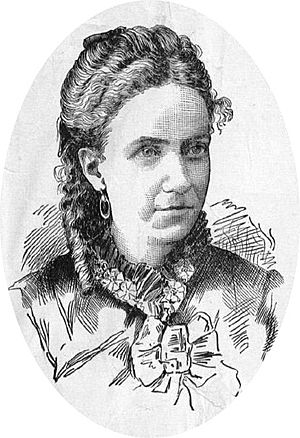Maria del Pilar Maspons i Labrós facts for kids
Maria del Pilar Maspons i Labrós (born in Barcelona in 1841, died there in 1907) was a Spanish writer. She wrote poems, novels, and stories. She was from Catalonia, a region in Spain. Maria used the pen name Maria de Bell-lloc (which means Maria of the Beautiful Place) for all her writing. She is famous for two main reasons. She was one of the first Spanish women to study and collect folklore. She was also the first woman to publish a novel written in the Catalan language.
Maria's Life and Work
Maria de Bell-lloc was an active writer starting in 1865. She lived during the "Renaissance Catalan period." This was a time when writers loved to tell stories about medieval heroes. They also wrote about patriotism and old traditions. Maria was one of the first women to study folklore. She went out to collect and write down Catalan legends. She also gathered stories about people's lives and cultures. Later, she rewrote and published these stories.
Maria loved her Catalan heritage. Her stories and poems were often set in the Vallès region of Spain. This area is near Barcelona. It was special to her because her family owned a manor house in Bigues. They often visited there.
Maria's poems appeared in many magazines. These were Catalan newspapers and journals published during her lifetime. From 1865 to 1882, her writing was in places like Calendari Català (Catalan Calendar) and La Llumanera de Nova York (The New York Feather). She also published two collections of poems. These were called Salabrugas (1874) and Poesies (Poems).
Joan Armangué i Herrero wrote about Maria's book Llegendari (Book of Legends). He said that Maria was a very important part of the folklore movement.
Maria is known for being the first author to publish a novel in modern Catalan literature. This novel was called Vigatans i botiflers (Loyalists and Traitors). It was published between 1878 and 1879. The story takes place during the War of the Spanish Succession (1701-1714). This war started when the king, Charles II of Spain, died without children. Maria's book describes the deaths of people fighting for independence. It also tells about the loss of Catalan rights during the war.
In May 1879, Maria published special poems and legends. They were in an issue of The New York Feather. This issue was about Catalan women. The writer Dolors Monserdà helped create it.
On May 13, 1880, the Catalan Excursions Association held a special event. They read Maria's Montseny traditions there. In 1885, Maria became an honorary member of the Catalan Folklore Section. This was part of the Catalan Excursions Association. Later, Maria published "Four Traditions" (1889) and "Four Other Traditions of the Time of the Recapture" (1894). These appeared in The Catalan Illustration.
Maria Maspons did a lot of research on Catalan folklore. She worked with her brother, Francisco Maspons y Labrós. His Catalan name is Francesc de Sales Maspons i Labrós. She also worked with her brother-in-law, Francesc Pelai Briz. They all worked together to collect Catalan folk stories. Francesc de Sales gathered fables, children's games, and traditions. Francesc Pelai focused on songs and riddles. Maria de Bell-lloc collected legends and traditions.
Main Works by Maria
Maria's works include many poems and legends.
- Lloances (Praises) (1866)
- Salabrugas, poesias catalanas (Salabrugas, Catalan Poetry) (1874). This book had an introduction by Joan Sardà.
- Narracions y llegendas (Stories and Legends) (1875)
- Vigatans y botiflers, novela histórica (Loyalists and Traitors, historical novel) (1878)
- Montseny (1880). This was a collection of six legends about the Montseny mountain.
- Llegendas catalanas (Catalan legends) (1881)
- Costums i tradicions del Vallès (Customs and traditions of the Vallès) (1882). The first part described customs, beliefs, and popular festivals. The second part had 22 legends about places in the Vallès region.
- Elisabeth de Mur (Elizabeth of Mur) (1924). This book included more than 70 stories.
- Poesies (Poems, undated)
Awards and Recognition
Maria did not win prizes for her poetry. However, she earned several awards for her other writings.
- First prize for the jasmine of silver in Lleida in 1869.
- Special Mention at the Floral Games literary competition in Barcelona in 1875. This was for her book Narrations and legends.
- Artistic and Allegorical Jewel award from the Catalan Excursions Association in 1880. This was for her collection of legends called Montseny.
- Scientific-Literary Prize from the Granoller's Casino in 1882. This was for a collection of stories, Costums i tradicions del Vallès (Customs and Traditions of the Vallès).
See also
 In Spanish: María del Pilar Maspons y Labrós para niños
In Spanish: María del Pilar Maspons y Labrós para niños


